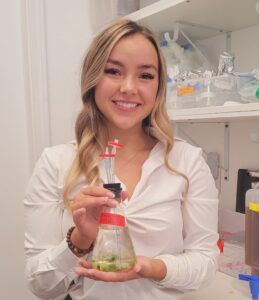
Taryn Godfrey was raised in a small town in Idaho and graduated from Grangeville High School in 2022. She is currently studying marine science and going into her second year at University of Hawaii at Hilo. Taryn enjoys being in the ocean, traveling, and spending time with friends and family. After graduating, Taryn plans to pursue a career in research where she can continue to learn about her environment.
Home Island: Mainland, Idaho
High School:
Institution when accepted: University of Hawaii Hilo
Evaluating Mitigation Methods for Non-Target Species Growth in Methanogenesis-Inhibiting Algae Cultures
Project Site: Blue Ocean Barns, Kona, HI
Mentor: Hannah Resetarits
Project Abstract:
Methane is one of the main atmospheric greenhouse gasses known to drive global climate change. To help reduce the agricultural production of methane, Blue Ocean Barns in Kailua-Kona produces Asparagopsis taxiformis, a species of red algae, as a food additive for ruminant livestock, such as cattle. Although many red algae produce bromoform, A. taxiformis is special for its ability to store bromoform in a “gland cell,” giving A. taxiformis the ability to store high concentrations of bromoform within its tissue. The bromoform is released when the algae is dried, and when A. taxiformis is added as a supplement to livestock feed, methane emissions from ruminant livestock are reduced by up to 90%. However, a common problem that arises during the cultivation of seaweed cultures is the unwanted growth of Ulva, a genus of green macroalgae that live in intertidal areas with a freshwater intrusion. Ulva have the ability to adapt to multiple different environments, which makes them difficult species to control or remove. This project investigated multiple potential methods to mitigate the growth of Ulva while minimizing harm to the surrounding A. taxiformis: exposure to varying concentrations and durations of bleach or salinity, long periods of air exposure, mechanical break-up of material, and depriving algae of nutrients. Culture health was monitored by measuring before-and-after weights in flask experiments, surface-area growth in well-plate experiments, nutrient levels, daily pH-level readings, and daily qualitative observations. Experimental outcomes and recommendations for the most effective Ulva mitigation strategies will be presented.